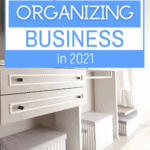There are so many benefits to starting your own organizing business. Professional Organizers are creative problem solvers who use their talents and experience to help others live a more serene and ordered life. Your organizing business plan will evolve over time by getting both specialized and on-the-job training.
When I’m coaching a new student to become a professional home organizer, we look at these three aspects of their professional organizing business plan:
- Establish a Client Process
- Set up a Legit Business
- Find Customers
For more free professional organizer training, watch my tutorials on YouTube and get your free launch guide HERE
Step 1 Establish a Client Process
You get an email, DM, text, call, or just a plain old face-to-face question: “How can I hire you to help me organize my life/home/workspace?”
OH NO … DON’T PANIC!!!
You have skills, a fab label maker, know the Container Store like the back of your hand, and your own home is masterfully organized. But you have no idea how to walk into someone else’s house and create order from chaos.
Then you ask yourself: “What would I charge? How long will it take? What products will I need?” And of course, they are asking you the same questions.
Before you are faced with that scenario, I recommend you create a simple process to take your client through that looks something like this:
My simple client process:
- Book a Call or Video Chat
- Schedule an Initial Consultation
- Schedule a Project Session
- Follow up & Repeat
Book a Call or Video Chat to Assess your Client’s Needs
Book a call or video chat to learn more about the space and your (potential) client’s needs, goals, and budget. This is your intake process. I recommend asking open-ended questions that get your client talking. Believe it or not, the more your client is speaking the more likely you are to book the job.
Being patient, friendly, and an active listener builds trust with your client. Before they hire an organizer, your potential customer will need to know, like, and trust you. And it all begins with that first contact.
▶get my intake form HERE + all the forms I use to run my business
▶get my exact client process + project management tips in this intro course designed to give you the confidence to book your first paid client
Schedule an Initial Consultation
From that first contact with your potential customer, be prepared to offer a paid service. You may find it easier to book an in-home consultation first, so have a rate prepared to offer them for an initial service. Come up with a rate you feel is fair for three to four hours of your time that is consistent with other home service rates in your market.
This time will be spent –
- Commuting to your client’s home
- Touring their home
- Discussing challenges and solutions
- Creating an action plan
- Following up with your client and answering questions
I call this: “organizing your home on paper.” Essentially you are providing your client with resources, design, and space planning ideas, storage solutions, and product recommendations. You are also a sounding board and creative facilitator.
▶Why organizers should charge for consultations
Schedule a Project Session
But Katherine, what if my client just wants me to organize one space like a closet or garage, can’t I just go in and start?
Of course, you can (and should!) take paid organizing projects. You’ll need to decide on a rate before you book that initial call with your (soon to be) paying customer. But I will warn you, without an initial planning session you may run into challenges like –
I showed up to organize a closet that I thought was filled with clothing, but it also contains boxes of papers that may need shredding.
Or
We planned on organizing the garage, but it’s filled with books, clothes, and other household items that need a place inside the house.
Or
I was hired to set-up a home office, but the office is hoarded with unopened QVC and Amazon packages. Do I deal with that first?
Book a project session that is a few hours in length to provide time for dealing with the unexpected and follow a basic project plan. My basic project planning method is called GDP which stands for
- G – Gather and sort like items
- D – Make Decisions
- P – Put away items in a neat and orderly fashion
Whether I’m organizing a junk drawer, a closet, an attic, playroom, or home office, following this method breaks the project down into manageable tasks, keeps me focused, and helps establish a timeline.
▶learn basic project management for Professional Organizers in my intro course
Follow up and Repeat.
A client in the hand is worth two in the bush. Ok, that’s not the exact phrase. But think of it this way –
If you are only working a few hours with each new client on only one space in their home, you will need 5 to 10 new clients each week to create a full-time business and salary.
Maybe you are a marketing genius or have a hit organizing show on TV, but more likely you’re like me. Someone who loves to organize and hates to sell themselves. If I had to secure 10 new clients every week, I would have given up years ago. So how can I work as a full-time organizer without marketing full-time?
Because I often declutter and downsize an entire home (not just one closet) and I have repeat customers. Building lasting relationships and connections around your ideal client base is essential to creating a sustainable organizing business.
Step 2 Set up a Legit Business
Once you have mastered your client process and understand how to manage an organizing project, you’ll need to set-up a legit business to minimize tax and legal challenges when taking organizing jobs.
Professional Organizing can be a lucrative business, but you do not want liability, legal, or financial issues to derail your business plan.
Here is a checklist to get you started –
- Decide on a Name for your business
- Ask your local government if you need a license or other requirements to operate in your area
- Meet with an attorney to determine your best legal structure
- Meet with an accountant to set-up bookkeeping + instructions on filing taxes
- Get business insurance
- Set up a business bank account
- Set up credit card processing
- Create a budget
- Set up a home office space
- Set up business e-mail, voicemail, and/or other messaging options
- Create forms and contracts
One of the best resources we have in the U.S. is SCORE. SCORE provides workshops and free mentoring to business startups. Connect with a SCORE mentor HERE.
▶get my intake form HERE + all the forms I use to run my business
▶click here for my Professional Organizer’s workbook + planner
Do not be afraid to set-up a legit business! It could save you a lot of hassles in the future and give you the confidence to become a transformative force in the lives of others!
Step 3 Find Customers
Now you know what to do when a potential customer wants to hire you and what it takes to set-up a legitimate business.
But wait … Katherine … I don’t have any customers and no one is hiring me!!
Help!!
Yes! The primary ingredient for any successful business is paying customers. I know I titled this section “find customers,” but really we need customers to find you.
You need to be top-of-mind in your community to attract your ideal client. To do that you will need to –
Be Visible + Be Known + Be Credible

▶7 Ways to Get Customers for your Home Organizing business
Make Your Organizing Business Visible
- Design a logo or color scheme (try Canva ❤❤❤)
- Get a business card (again, Canva)
- Create a website
- Set-up your business on Google
- Create a Facebook business page
- Create an Instagram business account
- Create a LinkedIn profile (or update your existing one with your organizing credentials)
- Create other social media business accounts where your ideal client could see (YouTube, Tik Tok, Twitter, Pinterest … really the list is endless)
It is a little overwhelming to think of all the places our customers can find us and nearly impossible to be known everywhere without a full-time marketing team. It will also take time to establish your business’s online profile.
Start with a platform where you are already engaged and have a community.
For example, if you spend a lot of time on Facebook or Instagram already and have a following, it will be easier to inform them of your new business venture. But if you have never shot a video in your life, YouTube can be a bit overwhelming. You may want to just start by listing your business with Google, creating a simple website, and build from there.
Be Known as the Professional Organizer who…
- Unpacks houses
- Loves staging and redesign
- Works with hoarders
- Downsizes seniors
- Teaches the KonMari Method
- Works with ADHD Clients
- Installs closet systems
What will set you apart from the competition? Even more important, what types of clients will other organizers refer to you? I call this niche marketing.
▶Free Niche Worksheet + Launch Guide
You must be known for something unique before others can refer business to you!!
Build your Credibility by…
- Speaking + giving workshops
- Attending networking events
- Getting to know related business and service providers IRL (in real life) over coffee, at trade shows, or community events
- Networking with other Professional Organizers like in NAPO or POC
- Writing and posting content to social media accounts and/or blog
- Following up with existing clients or e-mail list
- Making media appearances
- Getting published
- Training or earning a certification
- Writing and speaking for others
- Getting referrals from existing clients
- Posting content (tips and advice) to other’s social media accounts
Ok, yes, I’m listing writing and speaking twice. Here’s why:
You can post tips and advice via your own business channels like social media accounts, website, or IRL. And also you gain credibility when sharing information with another community‘s audience.
In the blogging world, this is called a backlink, or when another site posts a link to your content, blog, or website. Here is a backlink I received for garage organizing tips –
When I was a total newbie, I asked a closet design company if I could work their booth at a trade show. It gave me an opportunity to talk about my services in front of an ideal client.
I’ve presented to local neighborhood associations, thrift stores, libraries, and senior centers. In addition to gaining an audience, each group would publish my contact information on their website, newsletters, and social media accounts.
Yes! It is free and relatively easy to become visible and credible in your community.
What to do next …
If you are starting a home organizing business this year you will need to establish a client process, create a unique client experience, set up a legit business, and find customers. I would love to help you out!
>Watch tutorials on my YouTube Channel
>Get your free launch guide
>Read more about becoming an organizer
Happy Organizing!



























